
Official Edgar Rice Burroughs Tribute Site
Since 1996 ~ Over 15,000 Webpages in Archive
ERBzine 0942
Presents

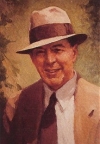 |
Memories from the Danton Burroughs Family Archive |
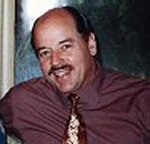 |
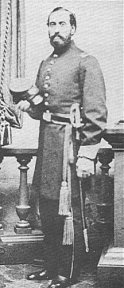
George Tyler Burroughs was born on October 13, 1833, at Warren Massachusetts. His parents were Abner Tyler Burroughs and Mary Rice who had wed in 1827 and had gone on to bear six children: Mary Louise, Sarah Ann, George Tyler, Henry Rice, Abner Tyler, and Caroline Studley. He attended an academy at Monson, Massachusetts, conducted by the Reverend Charles Hammond. Later he went into business in Columbus City, Iowa, as a merchant. It was here that he courted school teacher Mary Evaline Zieger, daughter of Mary Coleman and Josiah Zieger.Family genealogies for both families are included in
Memoirs of a War Bride by Mary Evaline Burroughs:
http://www.erbzine.com/mag9/0920.htmlBy the spring of 1861 George Burroughs had moved on to employment with the woolen department of Bliss, Wheelock and Kelley, a large New York importing house. He and Mary Evaline had planned a fall wedding and had selected their future home then being built in the suburbs. Their wedding plans, however, were suddenly postponed by the outbreak of the Civil War. Reading about Lincoln's call for volunteers in the morning paper, George walked to the nearest armoury and put his name on the enlistment list. He then informed his employers and resisted the many enticing offers they made to try to persuade him to stay with the company. He was sworn into the army on April 19, 1861, despite having limited vision in one eye -- the result of a childhood accident. He entered service in the Civil War as a private in Company "G" of the 71st Regiment, New York State Militia. The new recruit was in the hospital with dysentery when he learned that his company was marching to the front. He climbed out the window and caught up with his company -- he was reprimanded but was allowed to remain. In the advance on Manassas, June 16 to 21, he saw action at Sudley Springs and at the Battle of Bull Run. In the front rank of the Bull Run battle George felt a bullet pass through his blouse. It struck and killed the man behind him. After the disaster of Bull Run on July 21, the soldiers of the 71st, bewildered and in disorder, managed to reach Washington within the next two days. The letter he wrote from Headquarters 71st Regt. NYSM ~ Navy Yard, Washington D.C. on June 27 1861 is featured in ERBzine 0943.
With no further assignment George returned to his position at Bliss, Wheelock and Kelley's. He was mustered out at New York City on July 31, 1861, but on December 16 reentered service with a commission as First Lieutenant, 43rd New York Volunteer Infantry, "Albany & Yates Rifles." He served as acting regimental quartermaster from December 1861 to September 1862. After various battle campaigns, he was detached from his regiment and assigned to duty as acting commissary of subsistence on the staff of General F. L. Vinton and then, with a commission from President Lincoln, was made captain and commissary of subsistence on February 19, 1863. He remained throughout the war and was present in numerous campaigns.
George and Mary were finally married in her hometown of Iowa City, Iowa, on February 23, 1863 and immediately left for Washington. Mary spent the rest of the war following her husband from front to front. The newlyweds spent one day in Chicago and another at Wheeling, West Virginia, where Mary Evaline met George's three sisters -- Louise, an assistant principal of the Young Ladies' Seminary; Sarah, a teacher of drawing and painting in the same school; and Caroline, who was studying French and music. George's leave expired the day they finally reached Washington and Mary was left alone in the city.
Mary Evaline's fascinating Civil War experiences are described in her
Memoirs of a War Bride:
http://www.erbzine.com/mag9/0920.html
On July 22, 1865 George Tyler Burroughs was honourably discharged from service with the title of brevet major. He had served four years and two months with the Union forces. His resignation had been tendered "to enable him to return to his family and to establish himself in business." With Mary, his wife of two years, he soon left for Portland, Maine where he applied the skills he had learned as an army quartermaster to running a furniture business with two partners, John B. Hudson and H. B. Masters. Their business cards read: "George T. Burroughs & Co., Plain and Ornamental Furniture, Feather Beds, Mattresses &c., Lancaster Hall, Portland, Me." During their residence in Portland, two sons were born: George Tyler, Jr. in 1866 and Henry (Harry) Studley in 1868.
After the war he joined various military organizations. In 1867 he was elected an Original Companion of the First Class of the Military Order of the loyal Legion of the United States, Commandery of the State of Massachusetts, and was one of the thirteen Original Companions of the Illinois Commandery. In Illinois he was also a member of Post No. 5 of the Grand Army of the Republic and a life member of Apollo Commandery No. 1, Knights Templar. He was also a Freemason, joining in Portland, Maine, on April 6, 1867.
In 1868, George and Mary and the two boys moved to to Chicago and leased a townhouse on Washington Boulevard. Liquor distilling was a major Chicago industry and George invested in a number of distilleries, the most successful being the Phoenix Distillery. He went on to spend 25 successful years in the distilling business as vice president of the Phoenix Distilling Company and Abel Ames and Company. This venture established George as a prosperous businessman and the Burroughs family was welcomed into the upper class of Chicago society. George's brother, Henry Rice, moved from New York to 580 Washington Boulevard where he lived until his death on March 18, 1904 at age 67.
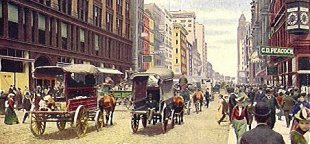
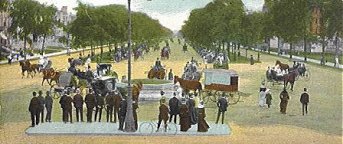
George's father, Abner Tyler Burroughs, who had lived his entire life as a farmer in Warren, Massachusetts, also moved to Chicago in 1868. A handbill announcing the sale of his farm and possessions gave the following description: "situated in Warren, Mass., 1-2 miles South-East from the depot. The farm will be sold entire or in lots to suit the purchaser and consists of about 125 acres of Land suitably divided into Mowing, Pasturage, Tillage and Woodland, well watered with a 2 1/2 story dwelling house, barn and other Out-Buildings thereon. . . ." Personal property included: "one fine carriage and saddle horse. One light, shift seat top Carriage. Two light, open buggies. One Milk Wagon. Five light, silver mounted harnesses, two of which are nearly new. One pair heavy ox harnesses. Three Ladies' saddles. Two McClellan Saddles. One English Saddle with bridles, 1 large, fine wolfskin Robe, 2 Buffalo Robes, 1 Fancy lap Blanket, 4 nice Horse Blankets, 1 India Rubber Horse Cover, &c." and all the family furniture and belongings. Stock and Farming Tools included: "one large yoke of fat oxen, 11 Winter Milk Cows, 1 Ox Sled, Wagon, Potatoe Planter which furrows, cuts, drops and covers at the same time." Farm produce included: "12 bbls. Cider, 50 barrels assorted Winter Apples, 100 bushels of Potatoes" and other items. Twenty-eight years later a Chicago newspaper in a story covering the 1896 election would report that ERB's grandfather, 90-year-old Abner Tyler Burroughs (husband of Mary Rice) had sold his farm in Massachusetts and come to live with his daughter Caroline in Chicago. He boasted that he was the oldest voter in the city and, "Since there has been a Republican Party, I have never voted any other ticket, and before that party was born, as an old-time Whig, I voted for straight Republican principles." Abner Tyler Burroughs was born May 26, 1805 and died on July 9, 1897.
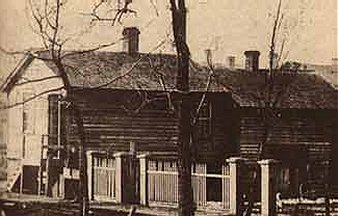
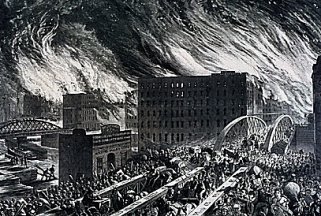
On the night of October 8, 1871, George and Mary along with their two boys, watched Chicago burn from the roof of their leased three-story, brick townhouse at 650 Washington Boulevard (Although well off financially, G.T. Burroughs never owned a home - see ERBzine 0932 ). One-third of the city was destroyed in the horrific Chicago Fire but their West Side neighbourhood was spared. Another son, Frank, was born seven months after the Chicago Fire and a fourth son, Arthur, died soon after his birth in 1874. (According to Harry Burroughs' daughter, Mrs. Carlton (Evelyn) D. McKenzie, two more children were stillborn.) Edgar Rice Burroughs, the youngest of the brood, was born on September 1, 1875. A birth certificate, establishes the birthplace as 650 W. Washington St., in Ward 13 and lists the father's occupation as "distiller" and the attending physician as Dr. E. Dyson.
George Tyler Burroughs was a vigorous and dynamic man who took an active role in political, civic, and social affairs. In 1881 he was called to Washington to testify as an "expert" in the November 14th and 15th trial sessions of the assassin of President Garfield (possibly because of his knowledge of guns). In November 1879 he was officially requested to assist in planning a reception given to General and Mrs. U.S. Grant by the Society of the Army of the Tennessee, at the Palmer House. Many other achievements followed, including: his appointment as United States Supervisor of Registry and Election in 1880 ~ he was selected as a delegate to the Republican Convention in 1880 ~ he officiated as vice-president of the citizens' and businessmen's Republican Ratification Meeting of April 2, 1887 ~ he attended the Republican National Convention in Chicago in 1888.
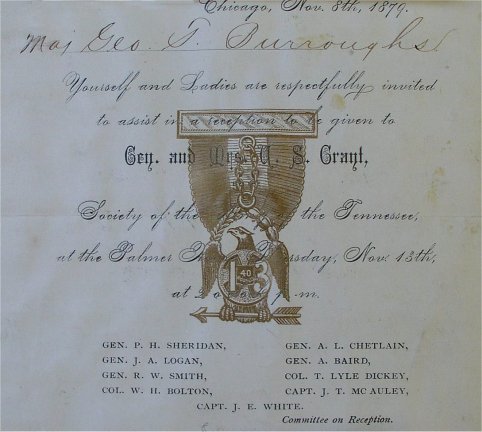 |
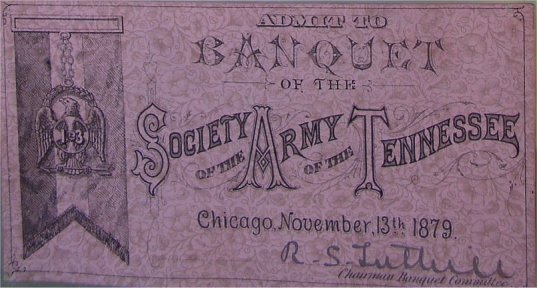 |
The major belonged to three military societies, the Masons, the American League and was lifelong Republican. He held very straight and narrow traditional views. He once said, "I would rather be found dead than found voting against the Republican party." In 1887 he was an official witness to the execution of the convicted Haymarket bombers who had been arrested after the Haymarket Square riots, a mass labor protest in May of 1886. In 1889 he was even excused from jury duty for his prejudice against Roman Catholocism after declaring "I have no prejudice against the individual, but I have against the religion. I do not believe in fanaticism anywhere."
|
(A clipping from the Burroughs private archives Apparently a jury-selection transcript.
|
Surprisingly, the Burroughses' long record of unwavering support of the Republican Party principles was abruptly broken in the McKinley-Bryan campaign. Bryan's fervor and his display of support for the workingman, plus Burroughs' intense dislike of the Republican boss Mark Hanna, led to a surprising switch to the Democratic Party. The decision was prominently featured in Chicago newspapers.
Further evidence of the wide range of Burroughs' involvement in civic and humanitarian matters came to light in a newspaper story of May 17, 1888. The paper reported that in 1865, James M. Johnson, a negro Confederate soldier, was discharged because of sickness and sent to Richmond to recuperate. There, quartermaster Major Burroughs helped him by bringing him to the Burroughs home in Warren, Massachusetts were he "was made practically one of the family" and was given an education. He went to work for Burroughs' brother-in-law, Charles McEntree (married to Caroline Studley, Major George's sister, on December 21, 1865) who had a chain of shoe stores. Johnson saved his money and eventually bought two of the stores when the chain was being closed down. Considering the prejudice of the times, it is quite remarkable that Burroughs and McEntree gave such generous aid to the man and that they were so willing to accept him as an equal.
George was very much the patriarch and the autocratic ruler of the Burroughs household on Washington Boulevard, a main thoroughfare with tree-shaded sidewalks and marble-fronted townhouses. The hub of the neighbourhood was Union Park with its sculpted lagoons, Gothic gazebos, caged animals, and sprawling greenspace. One of the functions of the park was to serve as a grazing area for the neighborhood cows brought there each day by the herdsmen. The Burroughs family was among those who kept a cow to supply fresh milk.They lived in upper-class comfort in a large house with servants and a carriage with a fine team of horses and coachman. The home was three-story townhouse with the dining room upstairs, a dumbwaiter, kitchen off the first floor, and a basement. There was an outside long flight of stairs, and underneath were doors going into a vestibule. The major's strict control over the household was always tempered by Mary's maternal common sense and moderation. Day-to-day operation of the Burroughs house was guided efficiently by Mary with the help of a cook and two Irish maids -- sisters Katie and Lizzie Sheridan.. She was a petite lady who exhibited great warmth and humour.
George on the other hand was a staid, conservative disciplinarian, insisting that the family follow his strict schedule: he liked steak for breakfast so everyone in the house had to eat steak for breakfast, a Chinese gong signalled a call to meals at 7:30 A.M., noon, and 6:00 P.M., and when he was ready for bed in the evenings, every gaslight in the house was extinguished. Major Burroughs could have been the prototype for Life with Father. To some degree he was at odds with son Ed's unusual imagination and his sternness must have had somewhat of a stifling effect on the youngster.He was an unimaginative man and to him there was only black and white, truth and untruth. A typical incident involves Ed rushing home from school one afternoon and announcing that he had just seen a purple cow in a tree. His father heard the statement and punished his young son for lying. Over the years, however, the major mellowed, losing some of his sternness and inflexibility, and his sons themselves growing up and acquiring more understanding, developed a deeper affection for him. The major was very considerate toward the household staff and in one case when a maid married the coachman, George got him a job with the police force.
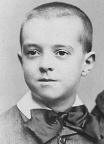

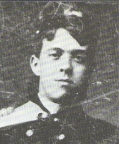
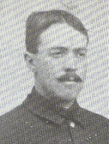
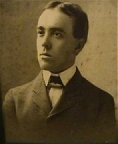

George Burroughs, a prosperous self-made businessman, had achieved success through hard work, determination, and the willingness to take risks. He was proud of his success, his place in life, and his ample income, and he wanted his sons to have all the advantages of his position and income. He paid for sons George and Harry's education in Yale and set them up in business after their graduation. The major inculcated a knowledge and appreciation of business transactions at an early age in his sons. One example of this is the note he wrote to 12-year-old Ed as part of a business game or actual transaction. He signed the note and dated it, February 21, 1887: "On or before March 1st 1888 for value received I promise to pay Edgar R. Burroughs Twenty Seven & 50/100 ($27 50/100) with interest at the rate of six percent per annum." For some reason he paid it off at a much later date than promised. Written across the note is the statement "Paid March 31st 1898 $46.12."
THE PHOENIX DISTILLERY FIRE On August 3, 1885 the Burroughs fortunes suffered a temporary setback. The Phoenix Distillery burned down and this led to a sharp drop in the Burroughs family fortunes. The loss was over $100,000 with only $35,000 covered by insurance. There is also good evidence that the major's financial losses were compounded by the dishonest practices of one of his business partners.The Chicago Tribune headline blared: "The fire at the Phoenix Distillery yesterday morning left nothing but the warehouse and the wine-room standing. These structures were saved through the well-directed efforts of the fire department, and thus a very great additional loss to the firm and to the insurance company was averted. The distillery, including the fine machinery and roller mill, was completely destroyed, nothing of the building being left."
"The Phoenix Fire a Loss of One Hundred Thousand Dollars with an Insurance of Thirty-five."It was noted that the firm had recently spent over $25,000 in new improvements and had "made the distillery probably the most complete in the United States."
The company was estimated to have made as high as S80.000 a year in profits. The Tribune gave further details:
"The cattle sheds were also completely destroyed, and the total loss will not fall far short of $100,000, uponwhich the insurance is but $35,000. The firm carried $40,000 insurance up to a short time ago, but allowed $5,000 to lapse within a short time, owing to the high rate charged by the companies on the risk."During an interview George Burroughs was reported as viewing the situation philosophically and even humorously, remarking:
"I am out of the whisky business for the present. The loss is a heavy one, but we can stand it, and we shall go right on and rebuild. We did a very profitable and large business, which, of course, must be somewhat interrupted. If we get out with a loss of from $50,000to $60,000 I shall feel satisfied. I have been out of town, and only came in yesterday, and I suppose that the show was got up for my benefit. But the exhibition was expensive, to say the least. I don't know the origin of the fire, and I don't think anybody else does "Whether the Phoenix Distillery was completely rebuilt is uncertain, but within a few years George turned to a new business, the American Battery Company, manufacturers of storage batteries used principally for train lighting and signaling. But his fortunes were on the decline and his income would never again equal the amount he earned from the distillery
Much later on April 17, 1920, as a sale of the old distillery property failed to materialize, Ed commented gloomily to Harry, ". . . I don't care very much one way or another as the distillery property has always been a hoodoo. It helped to kill Father and I am inclined to think it also helped to kill Mother. . . ." The sales efforts dragged on until 1923 when, in January Adelor Petit succeeded in selling the property for 88,000.
George, Jr. and Harry were an additional drain on finances as the expense of keeping them at Yale's Sheffield Scientific School was considerable. In addition to this, the boys travelled to camp each summer at Beaver Lake in Wisconsin -- something they had done all through their teens and into their Yale years (see the Burroughs Brothers letters in ERBzine).
The Burroughs fortunes soon rebounded, however, as George invested in the successful American Battery Company in which he was elected president. The factory manufactured a variety of batteries including ones for bicycle lamps, railway lights and electric automobiles. At this time the company office was located at 25 South Canal Street and the factory at Oregon, Illlinois. In the fall of 1888 he helped George, Jr. and Harry in their purchase of the new Chi Phi Fraternity House -- one of the finest fraternity houses in Yale. After graduation, the boys returned to work at the factory but, because of the unhealthy atmosphere created by battery chemical fumes, they soon moved to Idaho where, with their dad's backing, they invested in a cattle ranch on the Raft River with partner Lew Sweetser, a Yale classmate. George sent their young brother Ed to help with the range work on the Bar Y (Yale) over the spring and summer of 1891.
In the fall of '91 the major enrolled Edgar in Phillips Academy in Andover, Massachusetts. When the rebellious 16-year-old dropped out, his father entered him in Michigan Military Academy in Orchard Lake, Michigan where he excelled in many areas -- especially riding, football and the editing of school publications. Nevertheless, throughout his stay at MMA, George had to bail his rambunctious youngest son out of a number of scrapes. Although Ed failed the West Point entrance exams after his graduation from MMA in 1895, he made his father proud when he returned to the Academy to serve as a lecturer and assistant commandant.
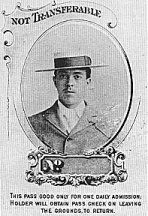
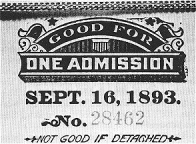
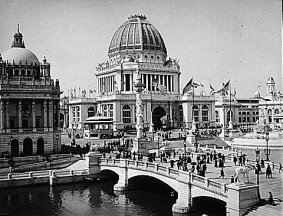
During the World's Columbian Exhibition in Chicago in 1893, George's American Battery Co. supplied the batteries for Chicago's first automobile. He gave young Ed the honour of driving this "nine-seater horseless surrey" around the fairgrounds. The nighttime demonstrations were particularly impressive as the vehicle threw off sparks and flashes of blue flame. Not so impressive were the many horse runaways that this new contraption caused all over the grounds. The award presented by the judges refers in glowing terms to George's product as "the only storage battery made in this country deemed worthy of any notice whatsoever."
In 1896, George gave the underage Ed permission to join the 7th Cavalry and he was assigned to Fort Grant, Arizona. It was not a good experience. Plagued with health problems, he coaxed his father to use his military connections to obtain a discharge for him on March 23, 1897, after serving 10 months of his three-year enlistment. Eventually Ed found his way back to Chicago, where he went to work with his father's battery company for fifteen dollars a week. He started at the bottom but worked his way up the ladder to the position of company treasurer. George raised his salary as a wedding present when he married Emma Centennia Hulbert on January 31, 1900.
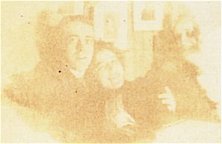
ERB BIO
TIMELINE
Compiled by Bill
Hillman
